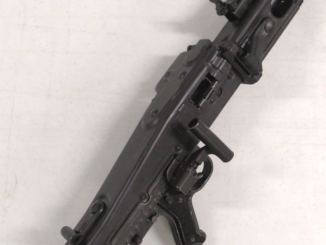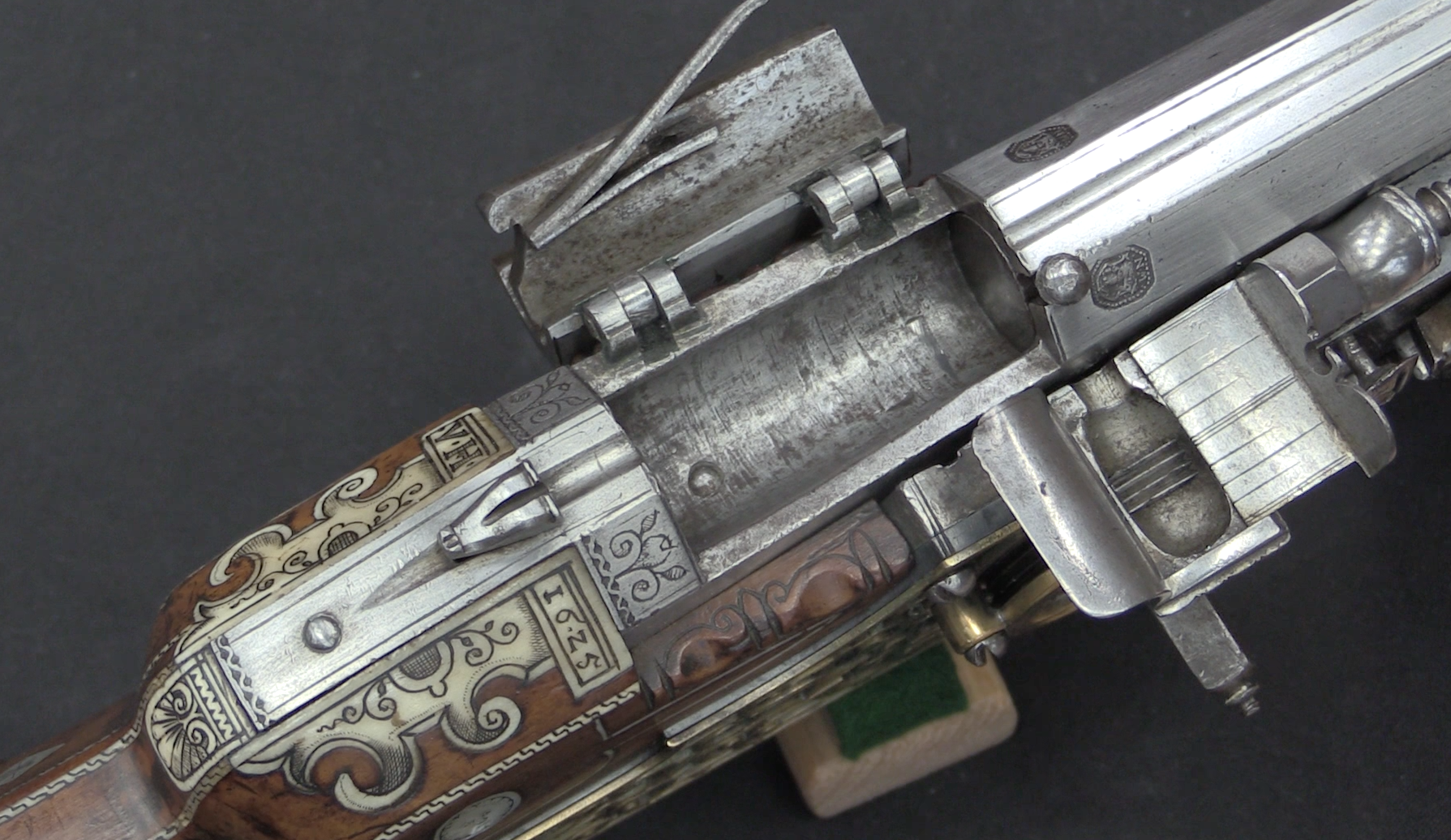In the 1920s Poland began looking for a new standard military pistol, and tested a variety of compact .380s. The representative from FN brought along an early iteration of the High Power (along with their other entry) even though it was much too large and heavy to meet the Polish requirements. After a couple iterations of testing, it became clear to the Polish Ordnance officers that the High Power was a much more effective service pistol than the compact guns they had been instructed to look for.
Lo and behold, the ultimate choice was a domestic design based largely on the High Power (a direct deal with FN was not an option after Poland’s relationship with FN had suffered through problems with the wz.28 version of the BAR). Toss in a delay to redesign the early decocking mechanism to satisfy the Cavalry (who didn’t realize that the decocker wasn’t actually meant to be used, but rather to just add another claim to the patent), and by 1935 the pistol was finished and formally adopted.
The Vis 35 is one of the best automatic pistols of WWII in terms of both handling and quality. In total 46,000 were made pre-war for Poland’s military, and German occupation forces built another 300,000+ during the war. Today I am looking at two; a German-production 3-lever example and a later German 2-lever version.




“a variety of compact .380s”
To be exact:
Not only .380, FN 1903 firing 9x20SR Browning Long and P.08 firing 9×19 were tested too. Finally only .380 automatic pistols advanced to final stage.
“Lo and behold, the ultimate choice was a domestic design based largely on the High Power (a direct deal with FN was not an option after Poland’s relationship with FN had suffered through problems with the wz.28 version of the BAR).”
In fact formal decision was done, in 1929, adopting FN High-Power. But due to hoax of PWU (Państwowe Wytwórnie Uzbrojenia, owner of Radom Arms Factory) it was not executed. PWU stated that is currently working on automatic pistol full-filing Polish Army requirements, dubbed PWU wz. 28 – in fact it was a lie, Wilnewczyc (designer of ViS) in few day drawn fake blueprints of this gun (see here: https://ioh.pl/artykuly/pokaz/a-na-tygrysy-mieli-visy,1081/ 2nd image from top) so FN High-Power was never adopted by Polish Army.
is: “never adopted by”
should be: “never produced for”
Can you tell us what the doctrine of pistol use in the interwar Polish Army and who was issued with a pistol, in addition to officers? I find it somewhat unusual that a small(ish) pistol was sought, since in most armies the sidearm was still the only weapon issued to officers; even to platoon leaders and company commanders. Weight and size of a sidearm was usually not a big issue unless the same model pistols were expected to be carried by various infantrymen, aircraft crews etc.
Sadly I don’t have Polish Army requirements for automatic pistol from 1927, but I know that improved FN, 13-shot pistol full-filled requirements, that one which don’t comply with requirement was no FN High Power as known today, but earlier version – that one version build to go around Browning’s patent, which FN sold to Colt with M1911 pistol (when these patent expired, FN designer Saive can use some solution which allow lighter mass).
French Army also early High Power as Pistolet a Grande Rendement (GR) and also reject it due to mass.
is: “also early”
should be: “also tested early”
According to Ezell in Handguns of the World, Ordnance wanted a 7.65mm pistol for officers, who would mainly carry it as a symbol of rank.
They also wore Sam Browne belts to support the pistol holster, thereby making themselves a bit obvious to enemy snipers, a common fault of officers’ uniforms all over back then. (Hence the term “Shoot Me Strap”.)
The cavalry, by comparison, wanted a powerful handgun because they weren’t able to handle a rifle effectively on horseback.
No, seriously. They were trained to charge on horseback, then after the line was broken, dismount, draw carbines from saddle scabbards, and fight on foot as skirmishers. In other words, dragoons. But they needed a pistol with serious killing power for that first charge. Not to mention being able to kill a horse -including their own- if needed. And the more rounds it held, the better.
Ordnance really liked the Browning M1910 in 7.65mm. The cavalry wanted the High Power in 9 x 19mm. Ordnance proposed meeting them halfway, with the M1910 in 9 x 17mm. The cavalry basically said, “ever try to kill a horse with a 9mm Short?” Also, they didn’t like the concealed hammer and small thumb safety, which would be an outright hazard on horseback. (This was their objection to the Parabellum 08 as well, BTW.)
The end result was the Vis.35. Bigger and heavier than Ordnance wanted (more expensive, too), not as many rounds as the cavalry wanted, but reliable and powerful enough to fit the cavalry’s requirements.
And it had an outside hammer that could be cocked one-handed by “wiping” the burr hammer down the trouser leg, and decocked with the hammer-dropper on the slide. Leaving the other hand free to hold the reins, as well as leaving no doubt as to whether it was cocked or not. All you had to do was look at it, or in the dark feel the hammer position with your thumb. And no small, easily-missed thumb safety; if the hammer was down, it was safe, if cocked, it was ready to shoot. Just like a single-action revolver.
Simplicity is a virtue in any sidearm. Doubly so for a cavalry weapon.
The Vis.35 was about the last military handgun specifically designed for cavalry use. It’s still a good sidearm, even if you’re not on horseback.
Just ask Lemmy Caution. 😉
cheers
eon
Hey Eon,
I bet I’m the only one here who got your “Alphaville” reference!
I have owned a VIS-35 (early Nazi) since the early 70’s. It was brought home by my Father-in-Law after WW-2. It has the Nazi holster and two magazines. The gun is extremely accurate. I have shot it quite a bit and have never had a malfunction. I find the de-cocker useful and erganomic. Thank you for including this weapon in your series.
Outstanding video, I have been waiting to see this wonderful pistol covered. Thank you for mentioning the risks and unfortunate execution of the workers who risked their lives to get pistols and parts to the resistance to fight the invaders. Also eventually the barrels were produced by Steyr to prevent the workers from smuggling complete guns to the resistance, so they stole what they could but had to fabricate their own barrels in secret to complete the guns.
Additionally you forgot to mention:
-On the early Polish eagle marked and early German examples had a shoulder stock cutout which was later eliminated.
– On the on the later pistols (nearing end of production)the grips were made of bakelite.
-The finish was changed to a cheap phosphate finish.
-P38 magazines/parts were re-purposed to fit the VIS-35. I have one magazine that is a VIS-35 body but has a P-38 base plate and can be disassembled similar in style to a High Power mag.
Well, I wouldn’t really call it a “doctrine”, since post WWI Poland was a dirt poor, war-ravaged country and the basic doctrine of the 1920s and early 30s Polish Army was basically “make do with what you have”. Poland back then had a dazzling mix of weapons of various origins (German, Austro-Hungarian, Russian, French, British and many others) due to complex WWI history and Polish-Soviet war of 1919-1921. Also, don’t forget that a pistol back then was considered more of a badge of honor than a serious weapon. The most commonly encountered were French and Spanish made .32 ACP (7,65x17SR) pea shooters of various brands (Ruby, Cebra, Astra etc.). There were also some Nagant and Lebel Mle. 1892 revolvers, Frommer and Steyr semi-automatic pistols, even some M1911s. What I didn’t really find was information about Lugers and Broomhandle Mausers, but it’s quite safe to assume that they were used as well. The early 30s marked the beginning of serious efforts to unify the equipment military-wide.
Yes, Polish Army used wide variety of weapon, it includes (data from 1931):
revolvers:
8mm Gasser
8mm St. Etienne
Smith & Wesson (model unspecified)
7.62mm Nagant Officer
7.62mm Nagant Soldier
English revolver (model unspecified)
automatic pistols:
7.65mm Mauser
7.65mm Frommer, 9mm Frommer
8mm Steyer (probably should be Steyr)
9mm Steyer
7.63mm Mauser
7.65mm Parabellum (long)
7.65mm Parabellum (short)
7.65mm Cebra
7.65mm Dreyse
7.65mm Pieper
7.65mm Selbstlader (? – mean self-loading in German, but there used as it was brand name – ?)
7.65mm Ortgies
7.65mm Browning
6.35mm FN Browning
7.65mm FN Browning
7.65mm Bayard
Also in pre-war Polish Army officers can bought and use own automatic pistol in lieu of service handgun.
For all the flak that Poles get, they made some good combat doctrines based on experience. Polish armored trains were practically panzer proof. The predecessor to the fictional “Wronski feint” was developed by Polish pilots to attack unescorted Luftwaffe bombers: dive head on and shoot at point blank range, then dodge victim’s plane at last moment. Guess how that turned out when the poles got into Spitfires…
They had to pay for the “service handgun” anyway.
Ian, thank you for such a knowledgeable resentation, Andrzej
ca.17 min – contrary to the narrative, the late-production Radoms did have a de-cocking lever – what they lacked was the disassembly lever. Instead it had a hook machined at the top of the hammer, into which one put the de-cocking lever’s ‘foot’, to hold the slide to the rear. You do not have to keep it cocked manually.
But otherwise it was really OK – and LONG overdue 🙂
I’ve always wondered how the Nazi elite found the peace to sleep at night knowing that one side of the mouth propagandized about the Polish untermenshen and the other side said: “Crank out more Radom pistols, we need them for our forces”!
Another example of Nazi “logic”:
Declare Waffen-SS to be finest of Ubermenschen
Declare Slavs to be Untermenschen which should be exterminated (or become slave labour force in best case)
Give Waffen-SS weapons (like ZK-383, ZB vz.30, PzB M.SS.41) invented and made in Czechoslovakia by mentioned Untermenschen
The Nazis actually made a habit of this sort of thing. When Hitler took over Czechoslovakia in early 1939, the Nazis inherited the Česko-moravská Kolben Danĕk (ČKD) and Škoda factories, which produced the TNHP and LTM-35 medium tanks. The Nazis continued production of both — renaming the TNHP the PzKpfw38(t), and the LTM-35 as the PzKpfw 35(t). Both served in enough numbers in the France and Soviet Union campaigns to be important in the outcomes.
The Ruger “P” series (e.g. P-89) used a decocking system almost certainly derived from this.
There was a new production example of the VIS at the 2014 shot show. I really don’t know what they were priced at. I thought it was around $8000 or $9000.00 which is reasonable compared to the
$!8,000 asked a few years ago for the new production Krieghoff Lugers The current Radom Factory also produced more of the super rare VIS shoulder stocks since 2000 than were made pre WWII.
The new production Krieghoff Lugers were wholesale priced at $18,000. Sorry. The rivets on the late Radoms were called ” Roll Pins” and were easy to disassemble. But you need to use a punch. The pleasant feel of the guns is because the grip frame flares out at the bottom. The circumference of the grip is quite small at the trigger level widening out at the bottom to be nicely hand filling. The accuracy of the Radoms is well known. In the 1970s a man in California even had a batch of Match grade barrels made for this Polish pistol. The blued finish on the early Polish eagle pistols is as fine as any to be found on early Colts or Smiths. The hardest Vis pistols to find are the very late ones with the slide marked BNZ . The late wood grips are very desirable also.
Ian,
You mentioned a different stamp being used after the double serial number scheme was discovered. Do you have a picture of the new stamp and the range of serial numbers when it went into effect?
Thanks,
Jim Kelly
Hi, my husband as an FB Radom Vis 35 given to him recently by his grandfather who got it from his stepfather. His grandad didn’t really know anything about the gun, but we did some digging & discovered it is a Polish gun made/assembled by the Germans during WWII. It has all 3 levers & the shoulder stock slot. The serial # is C4695. It says F.B.RADOM VIS Mod.35.Pat.Nr.15567. with P.35(p) below, German Waffenamp 77 & 623 inspector stamps & the eagle holding the Swastika. What year would you say it was made? Looking to have a plaque made with gun details for inside a shadow box for the gun. Thank you!
It would have been polish young ladies doing the work, for the nazis b/c the men died in the first two weeks of the blitz killing all the nazis and soviets. After the first two weeks there was a lull where the nazi young ladies in germany conscripted their children and sent then into poland to occupy under the larger soviet populations children soldiers. Eventually the us obliterated germany from the air and the nazi women and children and then rolled through poland and then rolled over western ussr and all the soviet children soldiers (literately on frosen forest trails). Then the uk made a deal with the ussr and backed off as the ussr took over poland again from the polish youth in warsaw. I was born in warsaw in ’78 and in ’81 the soviets were starving in their secret forest cities and started walking back to russia, so the polish army posted a soldiers on every city corner, rural & rail junction until ’90 when a new polish government was elected without any russian influence. Finally freeing the young ladies from their war-time service. Men farmed potatoes.